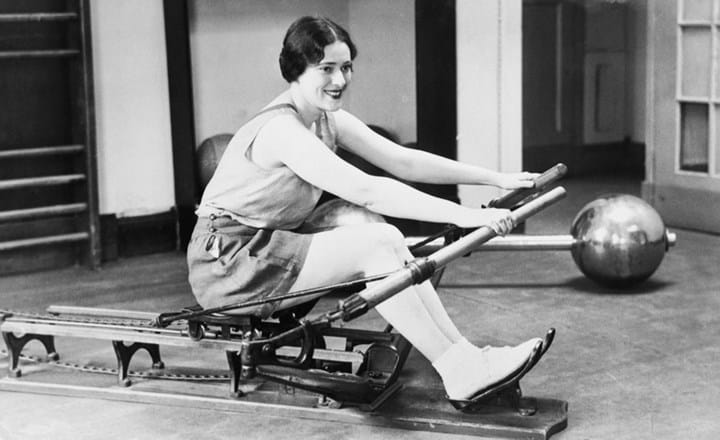
The Shadows of Our Past – How Past Innovations are Shaping the Fitness Industry Today
Part I – Landmark Innovations in Fitness Equipment
Introduction
Fitness, whether in the pursuit of physical excellence or the betterment of one’s health, is not a modern-day innovation. While today’s fitness influencers, proclaimed gurus and industry pundits believe modern fitness equipment, training programs and fitness settings started with them – the story long predates any of today’s fitness leaders. As the writer Marcel Proust so eloquently stated back in the early 1800s, “What we call our future is the shadow our past casts in front of us.” In essence, the fitness industry of 2019, and what it will evolve into, is merely our fitness shadows returning to life.
This article, the first in a three-part series on historical innovations that have shaped the modern fitness industry, focuses on 15 equipment innovations whose shadows still hover over us today. Parts two and three of this series will address the most influential innovations in fitness training and fitness facility settings. Their aim is to both entertain and shed light on how the innovations and lessons of our fitness predecessors offer insights into how we meet today’s industry challenges and tomorrow’s opportunities. This article, along with parts two and three are a ‘Tweet-sized’ version of the fitness industry’s history as told fully in the book, Legends of Fitness, authored by Peterson, O’Rourke and Tharrett.
Landmark Innovations in Fitness Training Equipment
The birth of fitness equipment, what we might refer to today as fitness training accessories, can be traced as far back as 800 B.C. Over the last 2,800+ years there have been numerous fitness equipment innovations that changed the course of how athletes, fitness enthusiasts and ordinary citizens trained and pursued an active lifestyle. What follows is a list of 15 fitness equipment innovations whose emergence and resulting influence remains in effect even today.
Dumbbells
In the pursuit of greater athletic achievement, the Greek trainers and athletes of 800 to 700 B.C. created the earliest dumbbells. This early versions of the dumbbell went by the name of halteres and were made of stone. Halteres were made in various sizes to provide athletes with varying degrees of resistance. Greek athletes used halteres for a variety of training movements, including lunges, plyometric jumps, running and general resistance training. Over time, these crude dumbbells evolved and by the 1700s were made of wood, and by the late 1800s consisted of a steel handle connecting two globes filled with iron shot. By the turn of the 20th Century, Alan Calvert, the founder of Milo Barbell had created barbells and dumbbells with steel bars that could be loaded with plates. Today’s dumbbells, while definitely more refined than earlier versions, remain highly similar to those first brought forward nearly 3,000 years earlier.
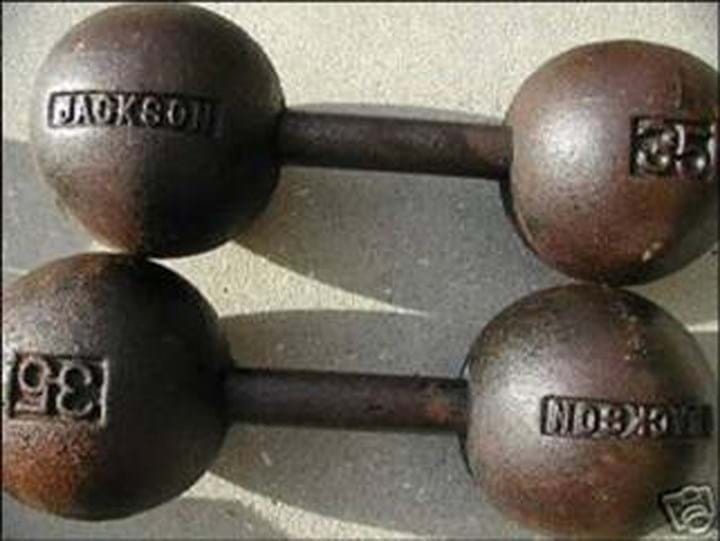
Medicine Ball
Around 300 B.C. Hippocrates – the originator of the Hippocratic Oath – introduced the first medicine ball. This was comprised of animal skin wrapped around a sand-filled interior and was used by athletes and fitness enthusiasts for lifting, carrying and throwing. Today’s medicine balls, slam balls, sand bells and sandbags are all modern imitations of the original medicine ball.
Kettlebell
Fast forward to the early 1700s when Russians, eager to demonstrate their prowess in local athletic competition, introduced the kettlebell – what they called the girya. The kettlebell soon became an essential training accessory for strength athletes seeking to enhance their physical prowess. The majority of kettlebells used today are not far removed from the originals used by Russian strongmen.
Barbell
In the 1700s, about the same time the Kettlebell was introduced, fitness practitioners introduced the “wand”. This weighted wooden stick was similar to today’s weighted bars, only heavier. The wand soon gave way to the barbell, which was comprised of either wooden sticks or metal bars with weights attached. By the mid-1800s barbells had evolved, comprised of a metal handle with globes on each end, filled with steel shot. These early “barbells” required total body control and engagement of the core. The first plate-loaded barbells, which are the standard today, were introduced around 1902 by Milo Barbell company.
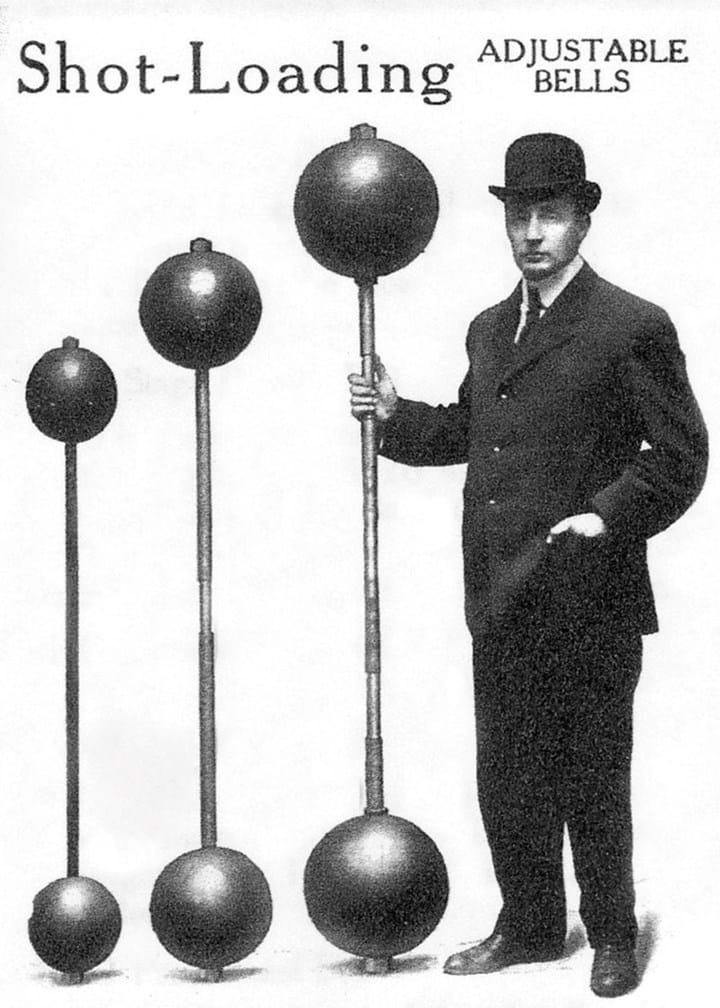
Indian Club
The Indian Club, introduced to the British military by native soldiers in India during the early 1800s, became a mainstay of physical training among the British military, and later among many global athletes. In 1834, Donald Walker, author of British Manly Exercise, introduced Indian Club exercises to the general male population as a mainstream form of fitness training. In 1866, the seminal textbook for Indian Club training was authored by Sim Kehoe. Today, the RMT club and ONNIT steel clubs offered by Roque are modernized conversions of these original training devices.
Variable Resistance Equipment
The first iteration of today’s variable resistance equipment was introduced in the mid-1800s by Dudley Sargent, a Harvard professor. His machines were called variable-resistance pulley machines. By the late 1880s, Dudley Sargent had created 56 different variable-resistance pulley machines with names such as the abdominal pulley system, the chest pulley system and the back pulley system. By the time he retired from Harvard he had created 56 machines, all housed in Harvard’s Hemenway Gymnasium. Many of his pulley systems became mainstays for early fitness facilities around the globe.
Around 100 years after the introduction of the variable resistance pulley machines, the next innovation emerged with the introduction of the Universal Gym in 1957 by competitive bodybuilder Harold Zinkin. Some of these early devices have evolved little over time, while others are now represented by today’s modern variable resistance machines made by firms such as Life Fitness, Matrix and Technogym. One of today’s modern variable resistance training devices that holds the greatest affiliation with the Sargent pulley systems are the machines produced by Freemotion.
Progressive Resistance Machines
Around the same time, Dudley Sargent was creating his variable resistance machines, Swedish physician Gustav Zander created his progressive resistance machines employing weights, pulleys, levers, springs, and cams (similar to what the original Nautilus machines had). In total, Gustav Zander created 27 different machines designed to be used for rehabilitative and performance enhancement purposes. The underlying principle behind his machines was what he called progressive exertion, whereby the load placed on the targeted muscles increased throughout the movement. Zander’s progressive resistance machines never really caught on with the public, but they re-emerged with the introduction of Nautilus machines in 1970. Arthur Jones’ introduction of the Nautilus represents the second stage in the evolution of variable resistance machines, offering progressive resistance via a modified cam system. One could argue that the early Nautilus machines were merely an innovative twist to Zander’s machines, some of which used cam-like pulley mechanisms. Today, there are many variable resistance models in existence, including Nautilus, with roots that go back to the first machines of Sargent and Zander.
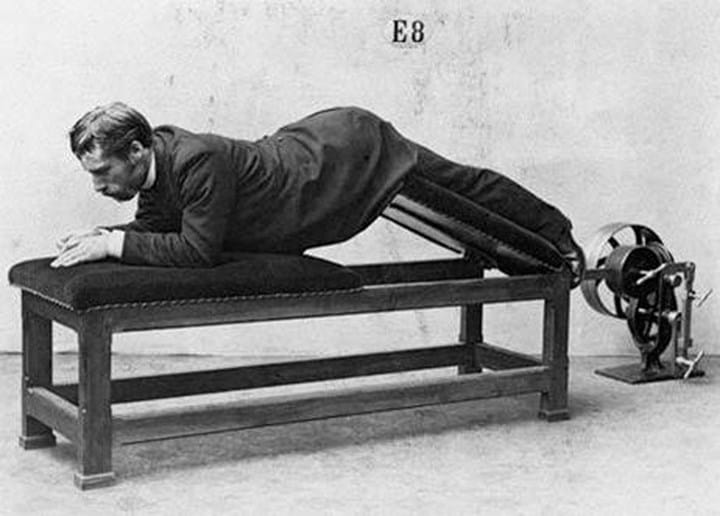
The Rowing Machine
Up until the 1800s, most cardiovascular training involved walking, cycling and running. In 1871, William B. Curtis introduced the Curtis rowing machine, which became the first piece of cardiovascular equipment designed solely for indoor training purposes. Curtis was an avid rower. As one of the founding members of the New York Athletic Club, which opened in 1868, he developed the rowing machine so individuals could train year-round no matter where they lived. The Curtis Rowing machine used a flywheel and ratchet system, subsequently becoming a template for future rowing machines, including those currently used in clubs and studios around the world.
The Manual Treadmill
As early as the late 1800s, the thought of engaging in cardiovascular activity indoors or on a piece of equipment was nothing short of crazy, or possibly torture. In the 1870s, Nicholas Potter received three separate patents for treadmills collectively referenced as “enterprise dog power.” The first patent, which came in 1871, applied to the pivoting track frame. In 1875, the second patent was received for the system used to elevate the platform, followed by a third patent for an adjustable and removable track frame. These early treadmills were called “enterprise treadmills” and still exist today. The first of these manual treadmills were actually used for walking dogs and later evolved into use with humans, similar to today’s many manual treadmills such as Technogym’s Skillmill and Woodway’s Curve and Curve Trainer.
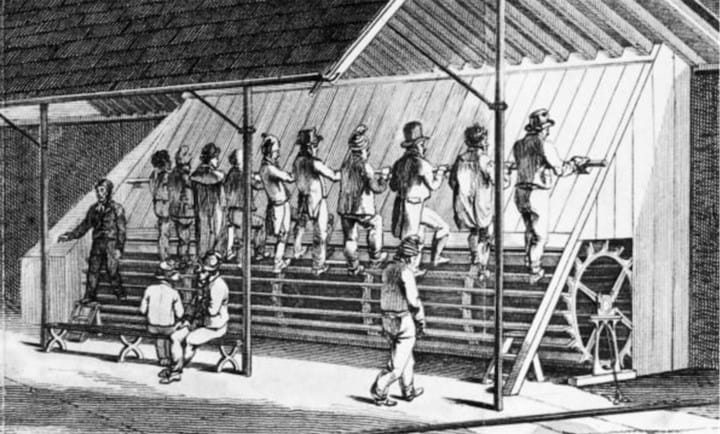
The Powered Treadmill
In 1889, Zuntz and Lehrmann developed the first motorized treadmill. This inaugural motorized treadmill was used in studies of human performance. In 1952, approximately 60 years after the introduction of the first motorized treadmill, Quinton introduced a modernized version called the Quinton treadmill, designed by Robert Bruce and Wayne Quinton. The Quinton treadmill was extremely well-built and became a staple of medical centers and universities. The Quinton treadmill also became the benchmark for today’s treadmills, though few of these modern versions are likely to have the lifespan associated with the early Quinton treadmills.
The Digital Indoor Bicycle
Up until the late 1960s, nearly all indoor bicycles were manually powered, but in 1968, Keene Dimmick introduced something completely new, an electronic bicycle called the Lifecycle. A few years later, Ray Wilson was introduced to the machine and quickly realized that it offered an entirely new element to the equipment currently being employed by fitness clubs. Wilson subsequently purchased the rights to Lifecycle, and soon hired college student Augie Nieto – who would go on to be one of the co-founders of Life Fitness – to bring the Lifecycle to market. Under the entrepreneurial spirit of Wilson and Nieto, the Lifecycle rapidly evolved into one of the two most important innovations to shape the modern-day fitness business. The Lifecycle 2000 was the first piece of “aerobic” training equipment to feature a standardized program for aerobic training, known as the “12-minute program.” Around the same time, the Lifecycle 2000 made a splash in the U.S., a German firm launched the Dynavit (1974) – an electronic ergometer whose development was part-funded by Chrysler.
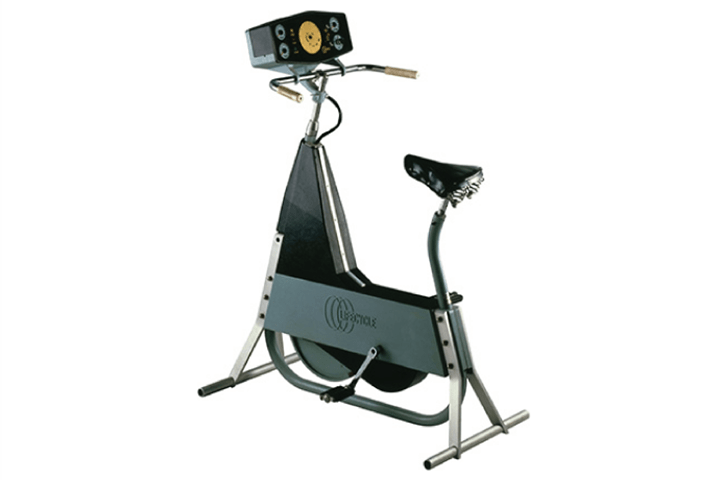
The Cross-Training Machine
The first powered bicycle designed for indoor use was created in 1932 by Gordon Berg, who was looking for a piece of equipment to counter his wife’s neuromuscular disorder. This resulted in the Exercycle, an exercise device that combined lower- and upper-body movements in a way that simulated rowing, swimming, cycling, and chin-ups. The bike was powered by a small motor that enabled users to go through a range of motion, with varying levels of resistance. The Exercycle was the first piece of exercise equipment that focused on providing cross-functional conditioning, for both the neuromuscular and cardiovascular systems. Many of today’s modern cross trainers are nothing more than modernized updates of this pioneering original.
The Stability Ball
Now a staple fitness accessory used by trainers around the globe, the stability ball was initially introduced by an Italian plastic manufacturer, Aquilino Cosani in 1963 and called the Pezzi ball. The Pezzi ball initially gained fame and fortune thanks to the efforts of British physiotherapist Mary Quinton, who used it with infants. The stability ball gained further prominence when Dr. Suzanne Klein-Vogelbach, director of the Physical Therapy School in Basel, Switzerland, incorporated the ball into her physical therapy protocols for neuro-development. Her exercises were entitled “functional kinetics.” Subsequently, American physical therapists called the device a Swiss Ball, which of course has now evolved into the stability ball.
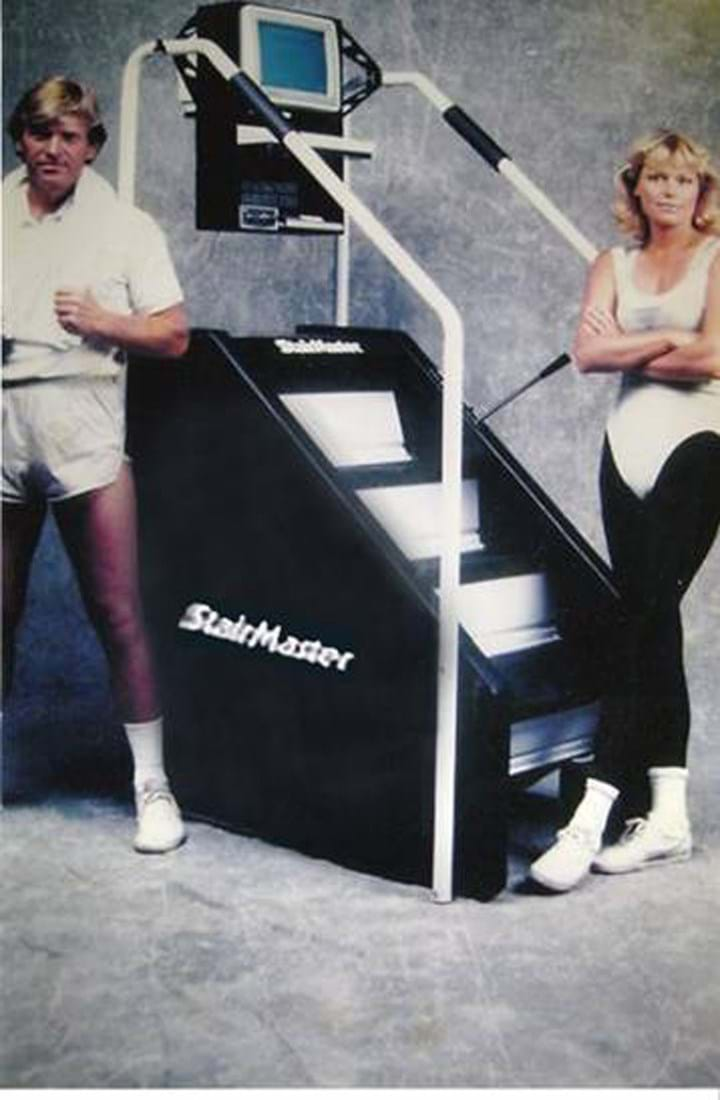
The Stair Climber
The very first stair-climbing machine, then referred to as a treadmill, was created by an English engineer William Cubitt in 1817. These early stair-climbing devices were introduced to torture prisoners by engaging them in intense exercise while concurrently starving them. These early stair-climbing machines were called treadmills, but when you see images of them it quickly brings to mind the first Stairmaster, which used a revolving stair. Beyond these rudimentary torture machines, the first official stair-climbing machine was introduced in 1984 with the launch of The StairMaster 5000 designed by Lanny Potts, one of the three co-founders of StairMaster Exercise Systems. The first Stairmaster 5000 featured rotating stairs. Two years later, in 1986, Randall Sports/Medical, formerly StairMaster, introduced the StairMaster 4000 PT mechanical stair stepper. The 4000 PT went on to become the single most popular piece of cardiovascular equipment in the 1980s and early 1990s. Over the past five years, stair-climbing machines have made a comeback of sorts, with new versions being made by multiple industry vendors.
The Elliptical Machine
The most recent non-digital innovation on our list is the elliptical trainer – introduced in 1995 by Precor. The EFX 544, as it became more commonly known in the industry, brought forward an entirely new mode of cardio training. The EFX was designed to provide individuals with a form of cardio training designed to lessen the impact forces associated with using a treadmill. The EFX gained incredible popularity upon its introduction, primarily due to users perceiving it as less intense and less discomforting than other forms of cardio training.
Final Thoughts
Thomas Carlyle, a Scottish philosopher once said, “The true past departs not; no truth or goodness realized by man dies; or can die; but all is still here, through endless change.” His words could not be truer when it comes to fitness, whether it’s the equipment, programs or facilities. In this first segment, I’ve brought forward some of the more interesting equipment innovations that I believe have exerted the greatest influence on the evolution of fitness. Or in the words of Thomas Carlyle, the equipment innovations that are still here through endless change.
Want to learn more about the story of the fitness industry? Visit HealthyLearning.com to order the complete book Legends of Fitness: The Forces, Influencers, and Innovations That Helped Shape the Fitness Industry

